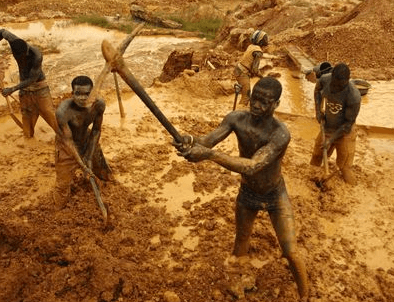The images are haunting: a string of viral videos shared widely across social media shows murky, brown sludge gushing from inland rivers into the sea, choking the once-pristine coastline, with schools of fish seen struggling against the suffocating filth, gasping for survival in a dying ecosystem.
What is the source of this cruelty to the fish? Illegal mining, locally known as galamsey, is poisoning Ghana’s rivers and oceans, threatening the very livelihood of coastal communities and the country whose survival is intricately tied to the health of these waters.
As researchers have indicated that over 60 percent of Ghana’s water bodies are contaminated due to galamsey and other environmental practices, fisheries experts, including the National Fisheries Association of Ghana (NAFAG), are sounding the alarm about the dire consequences for the fishing sector.
They warn that if these activities continue unchecked, Ghana will not only lose its freshwater and food production but also the impact of dwindling fish stocks and the very survival of millions who depend on the sea for food and employment.
The polluted pathway from rivers to oceans
Illegal mining has ravaged Ghana’s rivers such as the Pra, Offin, and the Ankobea through the use of toxic chemicals such as mercury and cyanide to extract precious minerals. These harmful substances leach into water bodies, poisoning aquatic life and disrupting ecosystems. As these polluted inland rivers are connected to the ocean, their flow downstream means carrying the heavily toxic chemically polluted water into the sea as all water bodies ultimately enter the sea.
The result is the contamination of marine life, particularly fish, which are an essential source of protein for millions of Ghanaians, as the Ministry of Fisheries and Aquaculture has revealed that Ghana’s annual demand for fish is about 1.2 million metric tonnes.
In Ghana’s coastal communities, where fishing is not just an economic activity but a way of life, this crisis poses a direct threat to food security. Communities like Elmina, Axim, Keta, Tema, and others have been sounding alarms, fearing for their future, as they continued to report dwindling fish stocks, unhealthy catches, and increasing signs that the toxic tide from inland mining is poisoning their seas.
The interlink between land and sea is undeniable; what happens to our rivers and land ultimately impacts our ocean ecosystem.
Impact on fish spawning areas
One of the most overlooked yet critical aspects of galamsey pollution is its devastating impact on fish spawning grounds. Many fish species, such as the sardinella, rely on freshwater ecosystems like estuaries and river deltas to lay their eggs and breed. When these areas are choked with silt, heavy metals, and other pollutants, fish are unable to reproduce at sustainable levels. The destruction of these spawning grounds therefore leads to a sharp decline in fish populations, which further exacerbates the depletion of marine life in the open sea.
The National Fisheries Association of Ghana (NAFAG), just like others in the sector, has called for the fixing of the challenge with the menace of illegal mining to help save the fishing industry, stressing that “there is something fundamentally wrong with our fisheries sector, which cannot be attributed entirely to illegal, unreported, and unregulated (IUU) fishing. Fix the challenge with galamsey and its effect on the fisheries sector, as there is a relationship between the inland water bodies and the ocean.”
Mr. Richster Nii Amarh Amarfio, the Vice Chairman of NAFAG, explained that “In the first place, the inland water bodies themselves are habitats for fish; they contribute to our fisheries demand, so when we destroy our inland water bodies, it puts unnecessary pressure on marine fisheries,” adding that galamsey and other bad environmental practices destroy the coastline, which serves as spawning places for fish, emphasising that destroying mangroves, brackish water, and estuaries meant destroying hatcheries and spawning grounds.
“It destroys the fisheries habitat because you are introducing toxic substances into your water, so you destroy the fish itself; they will move away from closer to shore into deeper waters. The juveniles that are spawned by the fish often generally move close to shore to avoid predators; therefore, destroying the coastlines would make it difficult to do so as they will die.”
Marine experts warn that this disruption to natural reproduction cycles can lead to long-term consequences. Dr. Jemimah Etornam Kassah, lecturer at the Department of Biology Education at the University of Education, has expressed worry about the quantity of heavy metal pollution from illegal mining activities being discharged into the ocean.
Dr. Kassah, who is also a Fisheries Scientist and an Aquaculture Professional, indicates that such pollution is the most notorious bane to the fisheries sector, expressing worry that Ghana is taking for granted the increasing time bomb it is sitting on with the galamsey menace.
Nutritional and economic impacts
The intersection between galamsey, depleted fish stocks, and malnutrition cannot be overlooked. Fish is the cheapest source of protein for Ghanaians, as about 60 percent of Ghana’s protein needs come from fish. According to the Food and Agriculture Organisation (FAO), Ghana’s per capita fish consumption is one of the highest in Africa, yet the country faces the risk of significant shortfalls in fish supply.
The World Health Organisation (WHO) highlights the importance of fish for brain development, especially in children, and warns that reduced fish intake could lead to long-term nutritional deficits in coastal populations. Malnutrition, particularly in vulnerable groups like children and pregnant women, could worsen if galamsey continues unabated. This creates a paradox: while some communities benefit financially from illegal mining activities, they are ultimately harmed by the nutritional consequences.
Experts warn that communities that rely on these fish as staples in their diets may turn to less nutritious, more expensive, or even harmful alternatives, exacerbating existing public health challenges as heavy metals like mercury and cyanide not only affect marine life but accumulate in the food chain. When humans consume fish contaminated with these toxins, they face significant risks, including kidney damage, nervous system disorders, and birth defects in pregnant women.
Economically, the livelihood of over two million people directly and indirectly depends on the fishing industry to make a living under severe threat. With the depletion of fish stocks due to pollution, fishermen are returning from sea with significantly lower catches, further impoverishing already vulnerable coastal communities. The ripple effects extend to fishmongers, processors, ice block makers, transporters, sellers, and even local restaurants that rely on fresh fish, many of whom are women, exacerbating food insecurity and poverty.
This goes beyond the fishermen. Fishmongers, ice block makers, transporters, and even local restaurants that rely on fresh fish have all felt the economic strain. If the trend continues, the loss of income in these communities could deepen the cycle of poverty, forcing many to abandon their traditional livelihoods altogether.
The dwindling fish catches being experienced by fishermen have already led to increased prices of fish in local markets, further straining the pockets of Ghanaians.
Charting a new path of solution
Solving the galamsey crisis and mitigating its impact on the fishing sector requires a multi-strategic approach, such as strengthening law enforcement. There is a need for a concerted effort to enforce existing environmental and water protection laws.
Local authorities, the military, and community leaders must collaborate to clamp down on illegal mining operations effectively. Stiffer penalties, including long-term
There must be extensive river reclamation efforts to restore the polluted water bodies to their natural state through replanting of vegetation along riverbanks, cleaning up riverbeds, and reducing sediment inflow.
Local communities must also be empowered with the tools and training needed to monitor and report galamsey activities.
With the potential collapse of the fishing sector looming, there is an urgent need to diversify livelihoods in coastal regions through sustainable aquaculture, which is fish farming in controlled environments. By investing in eco-friendly fish farming technologies, the government could provide fishermen with new opportunities to maintain their income while reducing the pressure on natural fish stocks.
All these cannot be achieved without increasing awareness among the general population about the dangers of consuming fish from polluted waters. This should be complemented by a national dialogue involving all stakeholders, including environmentalists, fishermen, policymakers, and the private sector, to collectively devise long-term solutions.
Conclusion
The menace of galamsey extends far beyond the quest for gold; it is a profound environmental disaster with irreversible implications for Ghana’s fishing sector and national food security. As rivers become conduits of toxic chemicals, they poison coastal waters and fish stocks, threatening the livelihoods of millions and deepening poverty in fishing communities.
The economic strain, coupled with the looming nutritional crisis, demands urgent, multi-faceted action. Solving the crisis requires a concerted effort, from enforcing stricter laws against illegal mining to reclaiming damaged water bodies and promoting sustainable fishing practices.
To safeguard Ghana’s future, all stakeholders, government, local communities, and environmental experts must come together to develop long-term solutions. It’s not just the fishermen or the rivers at stake; it’s the survival of entire communities, eecosystems, and future generations. Galamsey must be confronted now, before the seas are silenced and the rivers run dry of life.
By Laudia Sawer
Source: GNA

















